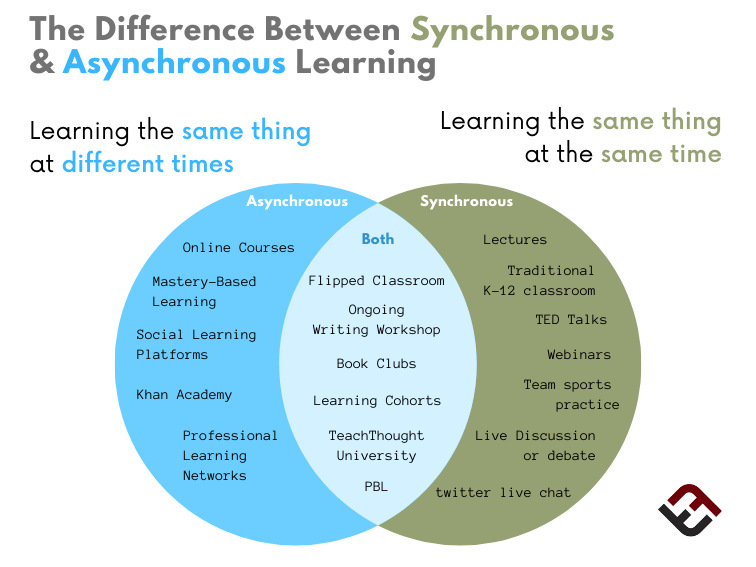What Is The Difference Between Synchronous And Asynchronous Learning?
by Terry Heick
Before we get into concise definitions and comparisons, let’s zoom back a bit and look broadly at the spirit of difference between Synchronous and Asynchronous Learning.
While it’s true that a significant difference between synchronous and Asynchronous Learning is, as the name (sync) suggests, a matter of timing, that misses thinking about the student and content more than the timing and format of the classes (an important shift).
Increasingly, through the growth of digital technology, the distinction is also a matter of place, pace, space, and pathway (I’ll dive into that in another post). But maybe more critical to understand than the concept of time is that of independence. Asynchronous learners are, largely, either learning alone or completing significant amounts of learning alone while synchronous learners work at about the same time on about the same thing.
See also What Is Remote Learning? A Definition For Teachers
Accordingly, asynchronous learners benefit from unique skills compared to synchronous learners. The former often have to be self-motivated, self-reliant, resourceful, and confident while synchronous learners are interdependent and while benefiting from learning together, also have to use unique skills to navigate those social interactions that can, well-designed, improve the learning experience.
With that out of the way, let’s look more closely at each.
A Long-Winded Preface
-I capitalized each to make the text easier to skim.
-An underlying assumption I am using is that students are simply learning the same content area (e.g. ‘Science’) rather than exactly the same activities and lessons and units and assessments. If we were to limit these examples of each to only when students are doing the exact same thing just at different times–well, that’s a lot less interesting and far too limiting.
-Note that there are exceptions to any of these. Sometimes students might gather in the same place at the same time to learn the same content but in a way that is not necessarily ‘sync’d.’ Think competency/mastery-based learning, for example, where students might move through the same content at a different pace. Compare that to almost the same situation– that same student this time using a platform with adaptive learning mechanics that scaled to their ability. While any student using this approach would indeed be studying ‘Math,’ it would be rare that two students would end up at the same place whenever that class, semester, or school year ended. Would this be ‘Asynchronous’ or ‘Synchronous’? The truth is, it depends on your terms–and it really doesn’t matter. In 20 years (if not sooner), these kinds of distinctions will look and feel completely different (if they’re not entirely obsolete).
-Push the definition a little further and it also could be argued that some of these examples in the graphic (and below) are in the ‘wrong category’–that Khan Academy isn’t necessarily ‘asynchronous’ because there is no perceived collective group unified by some characteristic (a class, club, or cohort, for example) studying the exact same material. While students do indeed access the Khan Academy curriculum at different times from different places, the argument could be made that it’s simply a learning platform rather than an example of Asynchronous Learning (whereas if a class of middle school math students used the platform on their own accord at their own times to learn the curriculum, that would then qualify as Asynchronous Learning).
Confusing enough? Well, don’t let it be. A lot of this is semantics while other confusion is due to the changing nature of each type of learning. As technology improves, Asynchronous Learning improves and often overlaps with Synchronous Learning. And as you’ll see below, there is often a mix of each. This is definitely not a ‘which is better’ but rather:
How are they the same?
How are they different?
How is each changing and why?
What are the relative strengths and weaknesses of each?
How can I use one or the other to supplement what I already teach?
See Also The Difference Between Inference & Prediction
Asynchronous vs Synchronous Learning
What is Asynchronous Learning?
As we explained in The Definition Of Asynchronous Learning, Asynchronous Learning (also called Location Independent Learning) is learning that is not dictated by collaboration, time, and place.
While there are always exceptions and variations, the overarching theme of Asynchronous Learning is independence. That is, in Asynchronous Learning, students access content without respect to their peers. Among other benefits, Asynchronous Learning is more flexible than Synchronous Learning–students can create their own learning schedule and use their own tools in their own self-organized space.
Short version: Learning (more or less) the same thing at different times
Examples Of Asynchronous Learning
Online courses (non-cohort-based), pre-recorded webinars or webinars without interaction, reading and audiobooks, learning through video playlists, social learning forums, digital platforms like IXL and Khan Academy, Self-Directed Learning, game-based learning (where the player is playing alone)
What Is Synchronous Learning?
What is synchronous learning? Synchronous learning is group learning that happens together–that is, students generally learn the same or similar content at more or less the same time and generally the same place.
As opposed to asynchronous learning, synchronous learning is characterized by the theme of togetherness. This implies other constraints–namely time, place, and pace (that is when learning happens, where it happens, and who controls the pace of that learning).
Traditionally, asynchronous and synchronous learning are thought of as types of eLearning, but most physical, brick-and-mortar classrooms are technically ‘synchronous’ while a self-directed learning environment where students learned ‘independently’ of one another–especially the same content–would technically be asynchronous.
Book clubs (depending on how they’re structured) are both synchronous and asynchronous–readers read the book on their own, then gather together to discuss. In that way, a book club so structured would be similar to a flipped classroom (which is also both synchronous and asynchronous).
Short version: Learning (more or less) the same thing at the same time
Examples of Synchronous Learning
Traditional brick-and-mortar classrooms, live webinars with interactions, whole class remote learning, conferences, TED Talks, lectures, face-to-face discussion, debate, real-time collaboration in project-based learning, sports team practice and other game-based learning where the players are playing together
I’ll explore some of the strengths and weaknesses of each and begin to show you how you can use one to supplement the other in your classroom.

